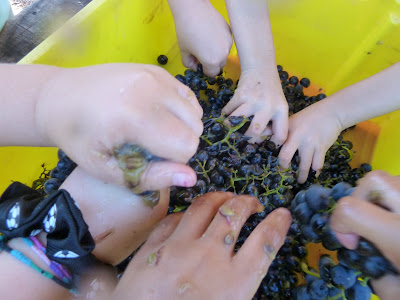In addition to the 5 acres of grapes that we farm by our house and 20 acres of grapes that we farm on leased land, we also farm two fruit orchards on leased land. We planted the orchards in 2006 and 2007 with peaches, plums, nectarines, pluots (a cross between a plum and an apricot) and cherries, along with apples, Asian pears, figs, berries (strawberries, blackberries and raspberries), quince, lemons and grapefruits. We sell the fruit to local restaurants and at the Napa Farmers’ Market and make jam for our Wine Club members.
 |
| orchard in bloom last winter |
We planted about 10 varieties of peaches, 5 varieties of nectarines, 10 different types of plums, and 4 different types of pluots. Choosing the varieties was a challenge, and we got advise from friends who were already growing these crops. At least two of the varieties that we planted, the Santa Rosa plum and the Fay Elberta peach, were bred by a brilliant horticulturalist name Luther Burbank.
 |
| Santa Rosa Plums |
Born in 1849, Luther Burbank, famous for breeding the Russet Burbank potato, the Freestone peach (any peach which comes away easily from the pit or stone), and the Shasta daisy, introduced more than 800 new varieties of plants. Though he is most famous for the potato that bears his name, fruit lovers might argue that his crowning achievement was the Santa Rosa plum. Introduced in 1906, the Santa Rosa is still the gold standard for farmers market plum flavor, though it has fallen out of favor commercially. As late as the 1960s, the Santa Rosa still accounted for more than a third of California's plum harvest; recently, it had dropped to only a percent or 2, as growers have abandoned it in favor of bigger, firmer and often blander fruit. And after you bite into a rich, tangy Santa Rosa, almost anything else tastes insipid.
Besides just eating the Santa Rosa plums when their juices drip down your face, they make the most delicious jam and tarts.
 |
| Santa Rosa Plum jam |
For the jam, I remove the skins and seeds and put them in a big pot with lots of sugar (to taste). The plums need the sugar to balance their tartness. Add some lemon juice, cook them down, and put the plum jam in jars….yum…the jam actually tastes a little like our wine!
Plum tarts are magical. Here’s a great recipe:
Poached Santa Rosa Plum Tart
Ingredients
1/2 cup sugar (4-5 Santa Rosa plums)
Superfine sugar for dusting (or finely ground sugar)
Prepared pâte sucrée tart shell (see below)
Preheat oven to 300 degrees. Make simple syrup by combining the sugar with 2 cups boiling water, stirring well to dissolve. (1) Cut the plums in half from stem to bottom, twist halves to separate, place skin-side down in a skillet, and (2) cover with simple syrup. Poach over medium-low heat until tender, approximately 6 or 7 minutes. Let cool for a few minutes, then remove gently onto a plate. Carefully remove the plum skins, keeping them intact, and lay on a parchment-lined baking sheet. Spread each skin flat and sprinkle with superfine sugar (or sugar that has been powdered in a small grinder). Bake at 300 for about 6 minutes, until they start to harden, then flip skins and sprinkle the opposite sides with sugar. Continue baking for another 6 minutes. Remove from oven and let cool, and raise oven temperature to 350. (3) Slice each half-plum into moons and fan over a baked pâte sucrée shell in a rectangular 4-by-14-inch tart pan. Sprinkle top with sugar and bake for 10 minutes at 350. When cool, remove from pan and cut into slices, topping each with a piece of candied skin.
Tart Pastry (pâte sucrée)
Ingredients
1-1/4 cups all purpose flour
1/3 cup sugar
3/4 cup (1-1/2 sticks) butter, cut in half-inch cubes
pinch of salt
2 egg yolks
1/2 teaspoon natural vanilla extract
In a mixer, or with clean hands, work together flour, sugar, butter, and salt until butter is incorporated, and the texture resembles coarse cornmeal. Form a well in the center of the flour-butter mixture, add the egg yolks and vanilla, and with a fork combine ingredients starting in the middle and working outwards until all is uniform. The dough should be soft; if it is sticky add a bit more flour. Line the bottom of the tart pan with parchment and brush with melted butter. Press dough in tart pan evenly. Prick the bottom of the tart with a fork and refrigerate for 30 minutes. Bake at 325 degrees until firm, but not brown, about 12-15 minutes.





















































